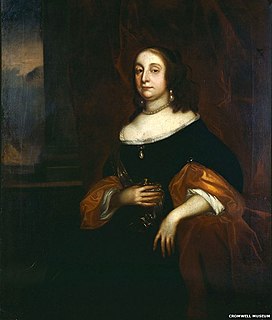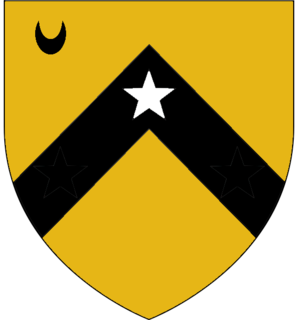Related Research Articles

Henry Cromwell was the fourth son of Oliver Cromwell and Elizabeth Bourchier, and an important figure in the Parliamentarian regime in Ireland.
Events from the year 1658 in England.
Sir Thomas Foote, 1st Baronet was a wealthy Citizen and grocer of London. He was Lord Mayor of the City of London in 1649. During the Protectorate he was knighted by the Lord Protector Oliver Cromwell in 1657, and after the Restoration (England) he was made a baronet by Charles II.

Elizabeth Cromwell was the wife of Oliver Cromwell, Lord Protector of the Commonwealth of England, Scotland and Ireland; and the mother of Richard Cromwell, the second Lord Protector.
Sir Thomas Beaumont, 1st Baronet was an English politician.
John Reynolds (1625–1657) was a soldier in the English Civil War and during the Commonwealth. Reynolds may have been a member of the Middle Temple. He joined the parliamentary army, and in 1648 he commanded a regiment of horse. He took part in the Cromwellian conquest of Ireland. He was a member of the Westminster-based Protectorate Parliament for Galway and Mayo in 1654 and Waterford and Tipperary in 1656. He was knighted in 1655. In 1657 he commanded the English force which cooperated with the French in Flanders in the Anglo-Spanish War and was lost at sea when returning to England.
Robert Tichborne was an English soldier who fought in the English Civil War. He was a regicide of Charles I.

Elizabeth Claypole was the second daughter of Oliver Cromwell, Lord Protector of the Commonwealth of England, Scotland and Ireland, and his wife, Elizabeth Cromwell, and reportedly interceded with her father for royalist prisoners. After Cromwell created a peerage for her husband, John Claypole, she was known as Lady Claypole. She was buried in Westminster Abbey.

Sir Henry Williams, also known as Sir Henry Cromwell, was a knight of the shire (MP) for Huntingdonshire during the reign of Elizabeth I. He was the grandfather of the Protector, Oliver Cromwell.
Sir Ralph Warren was twice Lord Mayor of London, for the first time in 1536 and the second in 1543.
The Other House, established by the Lord Protector Oliver Cromwell under the terms of the Humble Petition and Advice, was one of the two chambers of the parliaments that legislated for England and Wales, Scotland, and Ireland, in 1658 and 1659, the final years of the Protectorate.
Sir William Ellis (1609–1680) was an English lawyer, judge and politician who sat in the House of Commons at various times between 1640 and 1679, and supported the Parliamentary cause in the English Civil War.

Sir John Lenthall was an English Member of Parliament. He was elected MP for Gloucester in 1645, knighted by Oliver Cromwell in 1658 and made Governor of Windsor Castle from 1657 to 1660. After the 1660 Restoration of the Monarchy he was pricked Sheriff of Oxfordshire for 1672–73 and knighted a second time by Charles II in 1677.

Thomas Murfyn, was a Sheriff and Lord Mayor of London.
Payne Fisher (1616–1693) was an English poet.

Sir Oliver Cromwell was an English landowner, lawyer and politician who sat in the House of Commons at various times between 1589 and 1625. He was the uncle of Oliver Cromwell, the Member of Parliament, general, and Lord Protector of England.
Sir William Ryder was an English politician and Lord Mayor of London for the year 1600 to 1601. As mayor, he played a prominent role in quashing the abortive rebellion led by the Earl of Essex, by publicly proclaiming Essex a traitor, which immediately caused much of his support to melt away.
Sir John Reade, 1st Baronet has the unusual distinction of being granted a baronetcy by both Charles I and the Lord Protector Oliver Cromwell.
During the Protectorate period (1653–1659) of the Commonwealth of England, the Lord Protector reserved the power previously held by the monarch to confer knighthoods, baronetcies and peerages.
Henry Jones of Asthall Manor, Oxfordshire was an officer in the New Model Army during the Interregnum. He transferred to the new small Royalist army of Charles II, serving as a Life Guard until he was dismissed after becoming a Roman Catholic. With King Charles's blessing he raised an English regiment of horse (cavalry) known as English Regiment of Light Horse in France for the French Army of Louis XIV. He was killed in action at the siege of Maastricht.
References
- Burton, Thomas; Goddard, Guibon (1828), Rutt, ohn Towill (ed.), Diary, of Thomas Burton, esq. member in the parliaments of Oliver and Richard Cromwell from 1656 to 1659 ...: With an ... account of the Parliament of 1654; from the journal of Guibon Goddard, vol. 3, H. Colburn, p. vii–viii
- Cherry, George L. (1966), The Convention Parliament, 1689: A Biographical Study of Its Members, p. 49
- Fairholt, Frederick William; Dekker, Thomas; Heywood, Thomas; Jordan, Thomas; Tatham, John (1844), Lord Mayors' Pageants: History of Lord Mayors' pageants, Percy Society, p. 65
- Gilbert, Charles Sandoe (1820), An Historical Survey of the County of Cornwall: To which is Added, a Complete Heraldry of the Same, vol. 2:1, J. Congdon, p. 67
- Granger, James (1769), A Biographical History of England, from Egbert the Great to the Revolution: Consisting of Characters Disposed in Different Classes, and Adapted to a Methodical Catalogue of Engraved British Heads. Intended as an Essay Towards Reducing Our Biography to System, and a Help to the ..., vol. 2:1, T. Davies, p. 56
- Noble, Mark (1806), A Biographical History of England, from the Revolution to the End of George I's Reign;: Being a Continuation of the Rev. J. Granger's Work..., W. Richardson ..., p. 347
- R.R. (5 November 1859), "Titles conferred by Oliver Cromwell", Notes and Queries, Oxford University Press, pp. 382–383
- Shaw, William Arthur (1906), The Knights of England: A complete record from the earliest time to the present day of the knights of all the orders of chivalry in England, Scotland, and Ireland, and of knights bachelors, incorporating a complete list of knights bachelors dubbed in Ireland, vol. 2, London: Sherratt and Hughes
- Stace, Machell (1810), "Whitehall Sept. 3", Cromwelliana. A chronological detail of events in which Oliver Cromwell was engaged; from the year 1642 to his death 1658: with a continuation of other transactions, to the restoration, Printed for Machell Stace, pp. 174–176
- Thornbury, Walter (1878), The Lord Mayors of London, vol. 1, London: Old and New, pp. 396–416